 Video-based learning is here to stay. As video visionary Michael Litt puts it, “the play button is the most compelling call-to-action on the web.”
Video-based learning is here to stay. As video visionary Michael Litt puts it, “the play button is the most compelling call-to-action on the web.”
Every day, people watch one billion hours of video on YouTube. And that’s just one of many video platforms on the web. According to Cisco, 82% of global traffic came from video streaming or downloads in 2022.
The eLearning market is projected to reach $848bn by 2030. Video-based learning and video training solutions are a significant part of this trend.
After all, the way we learn has changed. We no longer reach for manuals or weighty instructional tomes. Instead, we visit Youtube, TikTok or video course libraries like Coursera and Udemy.
Videos help to expand our mind, skill-set and potential. If you’ve got five minutes spare, you can visit Youtube now to learn how to make a chocolate raspberry martini, how to juggle or how to cut an onion without crying. Good luck with that last one.
But training videos also have a role to play in structured workplace learning. You’re probably well aware of this fact. After all, 95% of organisations are already using video as part of their employee training toolkit.
With this in mind, we’ve created the ultimate guide to video-based learning. This article includes a clear definition, a breakdown of the benefits, tips and tricks, case studies and a look to the future. Ready for reel results? Then let’s get started.
What Is Video-Based Learning?
Video-based learning refers to any learning experience that is facilitated through video. Video, as you probably know, is a recording or reproduction of moving images produced digitally or on videotape.
Whenever video is used to share information or teach new skills, that qualifies as video-based learning. Simple, right? So let’s complicate things a little.
There are numerous types of video you can incorporate as part of a video-based learning approach. Below, you’ll discover some of the video types that are most commonly deployed as part of a structured workplace learning initiative.
Common Types of Video:
- Instructional: This video type (also known as ‘explainer videos’) is used to deliver information in an easy to understand format. For instance, ‘What is a Light Bulb?’.
- Demonstrative: This video type is used to illustrate how to perform a specific task or skill. For instance, ‘How to Change a Light Bulb’.
- Scenario / Case Study: This video type presents real-life examples and scenarios and encourages the viewer to think critically. For instance, ‘Eco-Friendly Light Bulb Trial: The Results’.
- Personality-led: This video type uses a charismatic presenter to engage and inform the viewer. For instance, ‘Lumina Wattsworth’s Guide to The Best Light Bulbs’.
Common Video Formats:
- Talking head: This format utilises an interview setup that features subject matter experts talking directly to camera. This form of direct address can be quite powerful.
- Performance-driven: You can also deploy actors or performers to create a narrative that conveys your message. This is great for adding detail to your scenario-based learning experiences.
- Animation: This video format uses motion graphics to communicate your learning objectives. This is useful for explaining abstract or complex concepts.
- Pre-recorded: This covers video that is recorded in advance so that it can be broadcast or shared later.
- Livestreaming: This covers synchronous video content that is streamed over the internet in real time. In other words, you’re viewing the footage as it happens.
- Interactive: This video format utilises interactive elements such as quizzes or decision pathways to create a more immersive experience.
As you can see, there are a variety of video types and formats for you to consider. To pick the right approach, you’ll need to consider the personas within your audience.
Take some time to understand what makes your learners tick. Then you can start building your training video plan with this in mind.
Your Learners’ Viewing Habits
Video has never been more in vogue. Content has always been king. And in the digital age, video is the king of kings.
- The number of digital video viewers across the globe is expected to reach 3.5 billion in 2023.
- We watch an average of 17 hours of online video per week. That’s 2.4 hours per day.
- We’re 52% more likely to share a video than other types of content.
- And 75% of viewers watch short-form video content on their mobile devices.
It’s safe to say that we’re video obsessed. But is this time well spent?
What Are The Benefits of Video-Based Learning?
Structured workplace learning is one big battle against The Forgetting Curve. To overcome this almighty foe, we must strive to forge genuine connections with our learners.
Without an engaged audience, you’ll never change your learners’ behaviour. And if you can’t achieve that, you won’t drive better outcomes or business impact.
Thankfully, video-based learning can help on multiple fronts.
1. Video Is More Effective
Training videos are uniquely powerful because they appeal to multiple senses at once. Video content contains both visual and auditory data. This helps you to communicate at a more effective and engaging level.
In fact, According to a recent study, viewers retain 95% of a message when it’s delivered via video. This compares to just 10% when it’s delivered via text.
What’s more, because videos provide a multi-sensory experience, they’re also good at conveying or showcasing complex concepts. It’s often easier to show than it is to tell. This leads to deeper and more meaningful learning experiences.
2. Video Is Easier to Process
You may have seen it claimed (across a variety of sources of varying repute), that people process visuals 60,000x faster than words. If that were true, that would make a compelling case for video-based learning.
Unfortunately, according to Email Audience, this claim has no actual basis in science. But don’t toss your video cameras in the bin just yet.
They suggest that the actual figure is closer to 600x, which is still a significant boost. After all, this means your learners are capable of processing your videos hundreds of times faster than your other materials.
3. Video Is More Engaging
When given the choice, video is our preferred way to learn. Research shows that our eyes are drawn towards movement. In fact, you’re 27 times more likely to click on a video ad than a static image ad.
According to Wyzowl, 36% of us have a preference for video-based learning. This makes it the most appealing training option, with one-on-one training in second place (25%) and work-based learning in third (17%).
Videos have a wide preferential margin. So, why not give your learners what they want?
4. Video is More Memorable
Video helps to improve your storytelling ability. As we know, a good narrative is a powerful learning device in and of itself. Combine this with compelling visuals and you’ve got a recipe for learning success.
After all, you’ll be in a better position to trigger an emotional response, which will help your content to live longer in your learners’ memories. Research shows that heightened states of emotion are more memorable than less dramatic experiences. It’s time to bring some flair!
There you have it. Video is more memorable, effective and engaging than alternative training methods. What’s not to love?
Of course, you’ll want to make sure that you get your approach to creating training videos just right. That’s what we’ll tackle next.
What Are The Principles of Effective Video-Based Learning?
Creating high-quality training videos requires combining sturdy educational principles with technical best practice. Take note of the tips below. Following them will ensure that your training videos pack a real punch.
1. Set Clear Learning Objectives
As with any other training material, every video you create should cater to a particular learning objective. As such, before you begin work in earnest, ensure you have this objective in mind.
You should be able to clearly state the learning outcomes you want to achieve. This will help both your video producers and your learners to stay focused.
2. Put Good In, Get Good Out
The success of your training video will be decided before you even pick up a camera. Your content needs to flow naturally and follow a clear structure. As such, take care to script and storyboard your video carefully.
Don’t forget to follow best practice. Include an introduction, explain key concepts step-by-step, highlight benefits and conclude with a handy summary and a call to action.
3. Don’t Skimp on Production Value
The quality of your video matters. Whilst you’re not attempting to create a Hollywood blockbuster, you should still put your best foot forward.
As HubSpot notes, 28% of consumers feel that video production value is ‘very important’. That’s almost a third of your audience. It’s little wonder too, given how much video content we all interact with on a regular basis.
As we’ll see later in this article, that doesn’t mean you need to hire a high-end studio or see if Kevin Bacon’s free for a day of filming. Proper planning and preparation can go a long way.
4. Capture Attention With Strong Visuals
Be bold. Your learners have a variety of distractions competing for their focus. Use compelling visuals such as diagrams, charts, animations and graphics to seize their attention and enhance their understanding.
Ensure all your assets serve a clear purpose and fall in line with your brand guidelines. Any resources you create for your video should also match the tone and style of your other training materials.
5. Engage Your Learners’ Emotions
Don’t be afraid to trigger an emotional response in your learners. Emotionally resonant experiences tend to linger longer in the mind.
As such, attempt to generate curiosity, surprise and empathy amongst your learners. To do this, you can’t rely on facts alone. Use your video to tell a compelling story and lead your learners on a profound emotional voyage.
6. Create Mobile-Friendly Videos
Ensure that all video content you produce is compatible with different devices. This includes desktops, laptops, smartphones and tablets.
In order to change behaviour, you will need to meet your learners where they are. According to Zippia, we check our phones 96 times a day. In fact, most of us can’t bear to be apart from our devices.
As such, many of your learners will access your content on their smartphone. You should provide them with an optimised and rewarding experience.
7. Keep it Short And Sweet
Your learners are busy. In fact, according to Statista, your employees are only setting aside 64-hours per year to focus on their development. That’s just 1.2 hours per week.
The bad news doesn’t stop there. Evidence shows that our attention spans are decreasing. This creates a challenging environment for learning professionals.
To circumvent this issue, you should follow microlearning best practice. Ensure your video content focuses on a single learning objective and is as short as possible. Don’t be afraid to make cuts and to break up larger topics into bite-sized chunks.
8. Improve Accessibility
Don’t leave any of your learners behind. Ensure every video you produce is suitable for your diverse audience. To do this, provide closed captions, transcripts and subtitles.
This will help you to cater to learners with different abilities and preferences.
9. Seek Out Feedback
It’s difficult to get things right the first time. And given the changing digital landscape, even seasoned L&D professionals still have a thing or two to learn.
As such, gather feedback from your learners and make refinements based on their suggestions. Regularly update your video content where possible and carry over lessons learnt to future projects.
How Can I Make Video-Based Learning More Engaging?
If you follow our previous suggestions, you’ll create video-based learning experiences capable of generating real impact. But if you’re seeking even higher levels of engagement, then there are still further steps for you to take.
1. Get Interactive
Watching a video is typically a passive experience, but it doesn’t have to be. Creating interactive videos is easier than you think.
With this in mind, consider adding interactive elements to your training videos. This could include quizzes, polls or reflection questions.
Interactive videos are also great for storytelling purposes. For instance, you could challenge your learners to make decisions that guide the outcome of your narrative.
2. Gamify the Experience
Gamification is the application of game mechanics to non-gaming environments to increase engagement levels.
Adding experience points, badges and leaderboards to your video content (or supporting learning environment) can help to incentivise learner activity.
After all, you’re helping to create a more dynamic, interactive and feedback-driven environment for your learners.
3. Embrace User-generated Video Content
As you likely know, creating high-impact training videos can be a costly and time-consuming process. Luckily, you’re not the only one capable of pulling this feat off. You have a pool of knowledgeable learners to call upon.
With this in mind, you should establish clear guidelines and provide all the tools necessary to help facilitate user generated video content.
Active learner participation can help you to successfully scale your training programme, embrace diverse perspectives and drive higher levels of relevancy. What’s more, you’re also encouraging learner ownership and empowering your audience.
What’s not to love?
Is Video-Based Learning A Cost-Effective Approach?
 Creating effective video-based learning content is not without its challenges. The cost of video production is arguably the biggest obstacle that will stand in your way. But don’t be disheartened.
Creating effective video-based learning content is not without its challenges. The cost of video production is arguably the biggest obstacle that will stand in your way. But don’t be disheartened.
According to F.Learning Studio, training video production costs around $300-$2,000 per minute. Yes, that’s a wide range. Ultimately, what you pay will depend on the type of video you’re making, production choices and the video effects you deploy.
As such, if you’re creating a library of video resources, it’s easy to see how you could quickly eat away at your budget.
That said, thanks to advancements in technology, video production is considerably cheaper than it used to be. It’s also worth noting that it’s a one-time cost. Your video is highly scalable and can be used again and again — as long as it remains relevant.
The same cannot be said for instructor-led training. Your training videos will generate no travel costs, instructor fees or general overhead. In fact, it’s estimated that you can save as much as 50-70% with video-based learning.
Cost-Saving Tips for Your Training Videos
There are also a number of ways for you to keep your costs down. We would recommend the following approach:
- Plan thoroughly: Stick to your script and storyboard to minimise shooting and editing time.
- Embrace minimalism: Don’t get too fancy with your set design, props and other equipment. Focus on the essentials. Talking head setups are relatively inexpensive.
- Bulk film: Shoot multiple videos at once to maximise your studio time and reduce your setup requirements.
- Use templates: Where possible, use presets and stock imagery to keep costs down. Always keep your audience in mind when making trade-offs in quality.
- Use and reuse: Remember, once you’ve created your training video there are no further costs. Deploy it through multiple channels and reuse it wherever possible.
If video-based learning is still proving too expensive, don’t be afraid to embrace more of a DIY-style. After all, most of us have high-powered cameras on our smartphones. Purchase a tripod, check the lighting, find a quiet space and hit record!
And if that fails, don’t forget that you can always rely on user-generated video content.
Video-Based Learning Success Stories:
Video-based learning has proven to be a valuable tool for employee training and professional development. But don’t take our word for it. Check out the case studies below.
1. Bayt.com:
Bayt.com is a leading job-search platform in the Middle East. Since implementing video as part of their structured workplace learning approach, they’ve seen some impressive results. According to their co-founder and CTO, Akkram Asaaf:
“Our training process is a lot cheaper than before. Knowledge retention is up by 40% and our employees are more receptive to training in their own time.”
2. EWR Digital
EWR is a digital marketing agency who focus on SEO and corporate video. They’ve found similar levels of success through video-based learning. Here’s what their CEO, Matt Bertram, has to say:
“We have found that video training boosts information retention. According to our internal data, the retention rate for video training is 60% higher than when using traditional methods.”
What Does The Future Hold for Video-Based Learning?
 Here at Growth Engineering, we like to look ahead whenever we can. And the future we see for video-based learning is very exciting indeed.
Here at Growth Engineering, we like to look ahead whenever we can. And the future we see for video-based learning is very exciting indeed.
Emerging technologies and innovative approaches are set to reshape the way we learn. And video is right at the heart of this revolution.
1. New Levels of Immersion
Virtual reality (VR) and augmented reality (AR) have opened the door to new levels of immersion. Deploying video in these environments will enable learners to interact with content as if they were in the same physical space.
Furthermore, 360-degree video enables learners to explore their learning environment thoroughly. This makes it easier to adopt different perspectives and viewpoints. As a result, your learners will be better placed to visualise and understand more complex concepts.
2. Real-time Collaboration
Social learning is a powerful training approach. Imagine if your video platform or learning management system enabled your learners to collaborate synchronously while watching videos.
Your learners would be able to share their thoughts and feedback via live chat, like and dislike elements and answer poll questions. They could even work together as a group to decide the outcome of any interactive elements within your video content.
3. Better Data
As training videos become more robust and interactive, you can expect your data to follow suit. Learning platforms will begin to offer more robust analytics and insights. This means that you’ll be able to go beyond simple completion rate reporting.
For instance, you’ll be able to analyse viewing behaviour. This includes when they start, stop and pause your content. You’ll also be able to access in-depth interaction reports, heatmaps, attention tracking and more.
There we have it. An exciting future awaits. And that’s before we’ve considered the role that artificial intelligence (AI) will come to play in video production. For instance, it’s not inconceivable that AI algorithms could be used to generate video content from text.
This will make video production faster, more cost-effective and more accessible. Now that’s a future that we could all get behind.
Video-Based Learning: Final Words
Learner engagement happens when you blur the line between education and entertainment. Video-based learning can help you to remove this line altogether.
We’ve seen that training videos are effective and engaging. We also know that they have a sticky quality that helps them to live rent-free in our minds. What’s more, technological advancements mean that they no longer need to cost an arm and a leg.
We hope that our video production tips and engagement suggestions help you to upgrade your training strategy. The future awaits. You just need to press play.
Ready to take your instructional strategy to the next level? Fuel your growth by downloading ‘The Ultimate eLearning Instructional Design Guidebook’.









